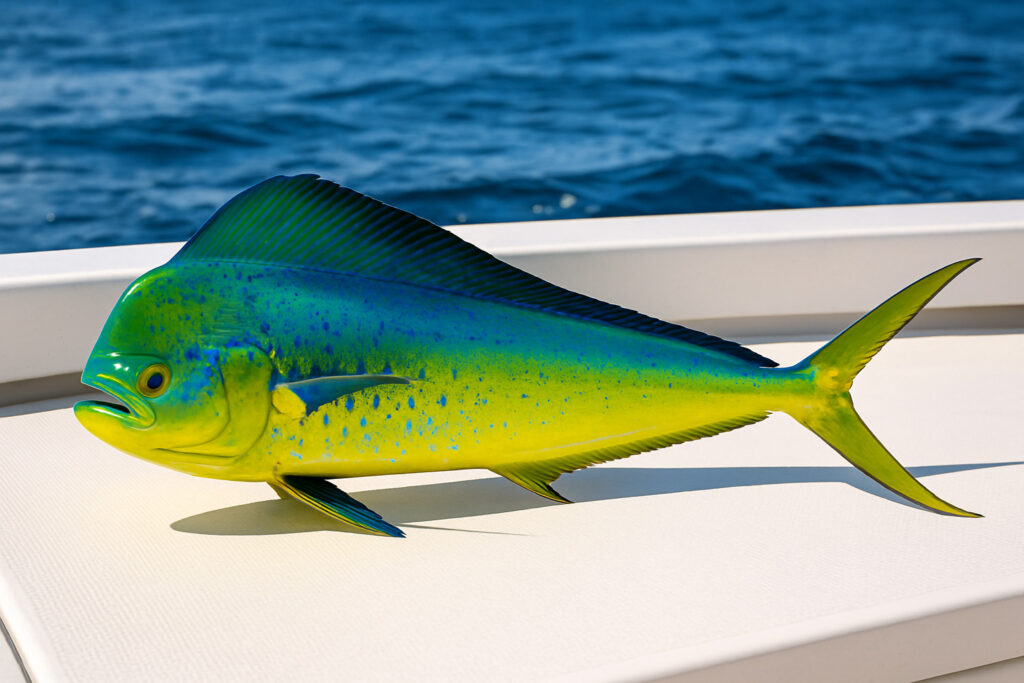Why Mahi Mahi is the Ocean’s Most Versatile Catch
Mahi mahi is a fast-swimming, surface-dwelling fish found in tropical and subtropical waters worldwide. Also known as dorado or dolphinfish (though it’s not related to dolphins), this vibrant fish has become a favorite among both anglers and food lovers for its mild flavor and sustainable fishing practices.
Quick Facts About Mahi Mahi:
- Scientific name: Coryphaena hippurus
- Other names: Dorado, dolphinfish, lampuka, shiira
- Habitat: Open ocean, tropical to subtropical waters
- Speed: Up to 50 knots (57.5 mph)
- Lifespan: 4-5 years maximum
- Taste: Mild, slightly sweet with firm, flaky texture
- Sustainability: Best choice when US Atlantic-caught with hook-and-line
This remarkable fish grows incredibly fast – reaching over 4 feet in their first year and spawning every 2-3 days once mature. Their rapid reproduction and hook-and-line harvest methods make them one of the most sustainable seafood choices available.
When a mahi mahi takes the hook, its colors are brilliant blue and silver dappled with yellow – a sight that has captivated fishermen for centuries. The Hawaiian name “mahi mahi” means “very strong,” referring to their vigorous swimming and fighting ability.
Whether you’re grilling fillets with citrus, making fish tacos, or trying your hand at ceviche, mahi mahi’s mild flavor and firm texture make it perfect for countless preparations. With moderate mercury levels and high protein content, it’s also a healthy choice when enjoyed responsibly.
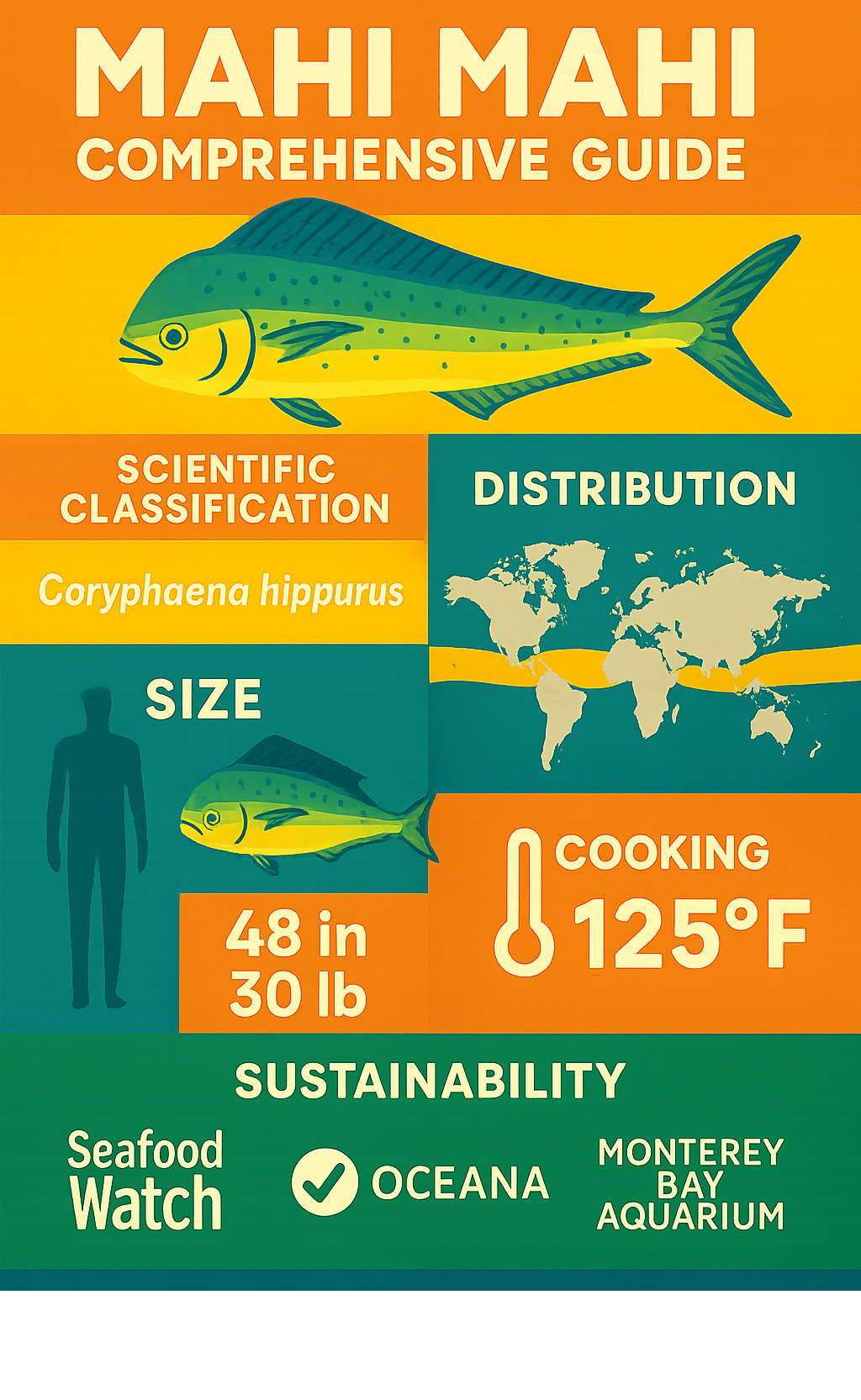
Mahi mahi terms simplified:
What Is Mahi Mahi? Names & Identification
When you first see a mahi mahi in the water, you’ll understand why fishermen have been captivated by this fish for centuries. These ocean athletes display some of nature’s most spectacular colors – brilliant electric blues, shimmering emerald greens, and vibrant golden yellows that seem to dance across their bodies as they swim.
What makes mahi mahi truly fascinating is their incredible color-changing ability. When they’re excited, hunting, or fighting on the line, their colors intensify and shift like a living kaleidoscope. Sadly, these magnificent hues fade quickly once the fish is out of water, cycling through multiple color phases before settling into a more muted grey-yellow.
The mahi mahi has a sleek, torpedo-shaped body perfectly designed for speed. You’ll immediately notice their distinctive blunt forehead – especially dramatic in males who develop a pronounced hump as they mature. Their long dorsal fin runs almost the entire length of their back, while their deeply forked tail gives them that classic game fish silhouette.
One of the most interesting aspects of mahi mahi is the clear difference between males and females. Males sport that iconic bulbous forehead that becomes more pronounced with age, while females maintain a more streamlined, rounded profile throughout their lives.
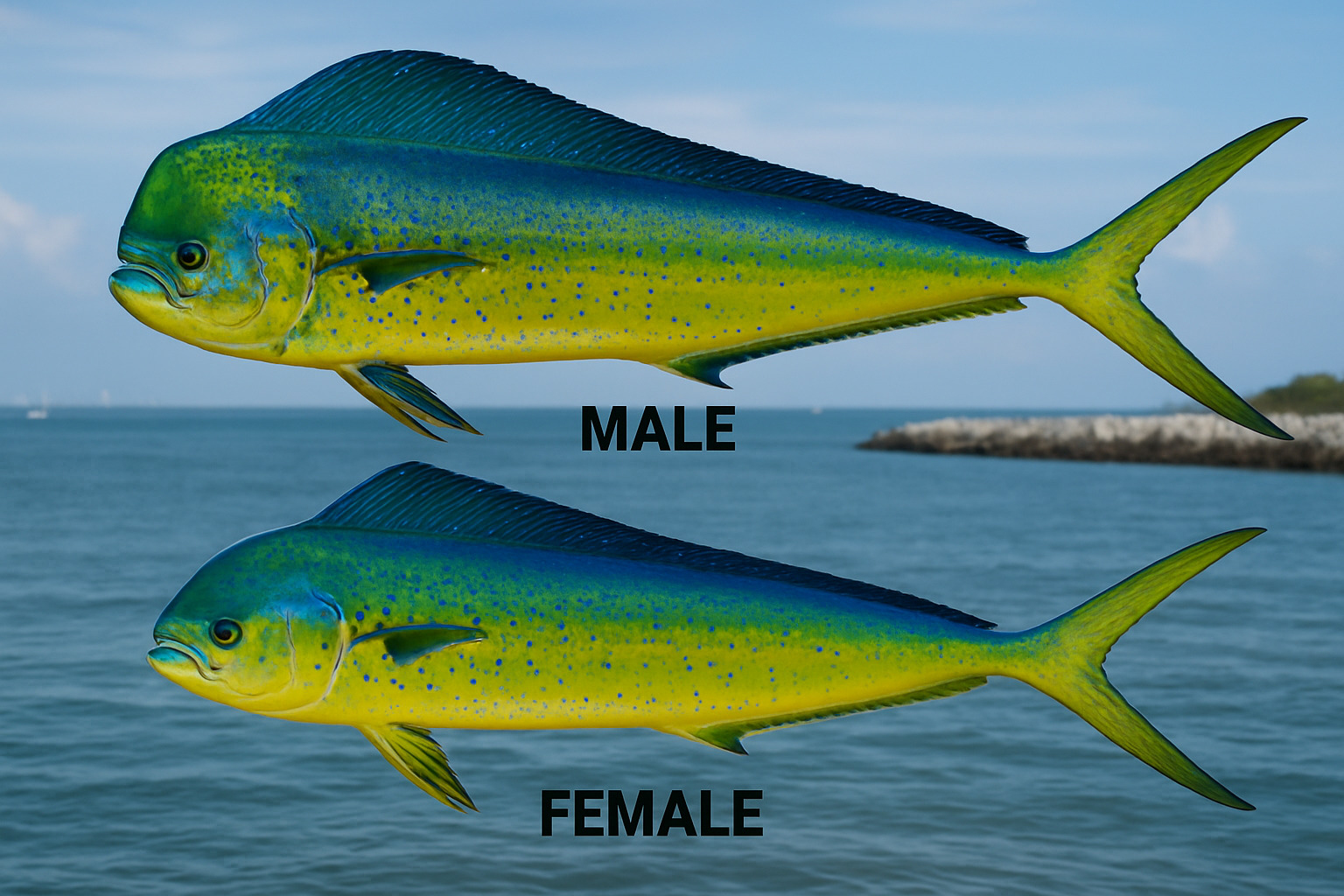
Now, let’s clear up a common confusion – despite being called “dolphinfish,” mahi mahi has absolutely nothing to do with dolphins. Dolphins are marine mammals, while mahi mahi is a true fish. The Hawaiian name “mahi mahi” literally means “very strong” (the repetition emphasizes the strength), which perfectly captures their powerful swimming ability and fierce fighting spirit.
Common Names for Mahi Mahi Around the World
The mahi mahi’s global popularity has earned it dozens of regional names, each reflecting local culture and language. In Spanish-speaking countries, it’s called dorado, meaning “golden one” – a perfect reference to those stunning yellow hues. Mediterranean fishermen know it as lampuka, while Japanese anglers prize their shiira.
German speakers call it goldmakrele (gold mackerel), and Malaysians refer to it as ikan lemadang. In some Spanish regions, you might hear calitos instead of dorado. Interestingly, while “mahi” means “fish” in Persian, this is purely coincidental to the Hawaiian origin of the name we commonly use today.
Each name tells a story about how different cultures have encountered and valued this remarkable fish throughout history.
How to Spot a Fresh Mahi Mahi Fillet
Knowing how to identify fresh mahi mahi at the market is crucial for getting the best flavor and texture. Fresh fillets should have a beautiful translucent pinkish-white color that almost seems to glow. If the flesh looks grey, brown, or dull, keep looking.
Give the fillet a gentle press with your finger – fresh mahi mahi feels firm and springs back immediately. The texture should never feel mushy or leave an indentation. You’ll also notice a bright red bloodline running through the center of the fillet, which is completely normal and indicates freshness.
Your nose is your best friend when buying fish. Fresh mahi mahi should smell like the ocean – clean and briny, never fishy or sharp. If there’s any hint of ammonia or strong fish odor, walk away.
If you’re buying skin-on fillets, look for bright, metallic-looking skin that still has some of that natural shimmer. You’ll want to remove this thick skin before cooking, and many people prefer to trim away the red bloodline for the mildest flavor, though it’s perfectly safe and nutritious to eat.
Natural Habitat & Fast-Growing Biology
Mahi mahi are the ocean’s speed demons, living life in the fast lane in more ways than one. These remarkable fish call the open ocean home, rarely venturing deeper than 250 feet below the surface. Instead, they cruise the sun-drenched upper waters where they can show off their incredible swimming abilities.
Picture this: you’re out on the open sea and spot a floating mat of sargassum seaweed or some drifting debris. Chances are good there’s a school of mahi mahi nearby, hunting for the small fish, squid, and crustaceans that also gather around these floating oases. They’re smart hunters who know exactly where to find their next meal.
When it comes to speed, mahi mahi are absolutely phenomenal. They can rocket through the water at up to 50 knots – that’s nearly 58 miles per hour! To put that in perspective, they could easily outpace most recreational boats. This incredible speed helps them chase down prey and escape predators in the vast open ocean.
But here’s where things get really interesting: mahi mahi grow faster than almost any other fish in the sea. We’re talking about fish that can pack on 5 pounds per month and reach sexual maturity in just 4 months. Scientific research on growth shows these fish live fast and reproduce young, with most not surviving beyond 4 years in the wild.
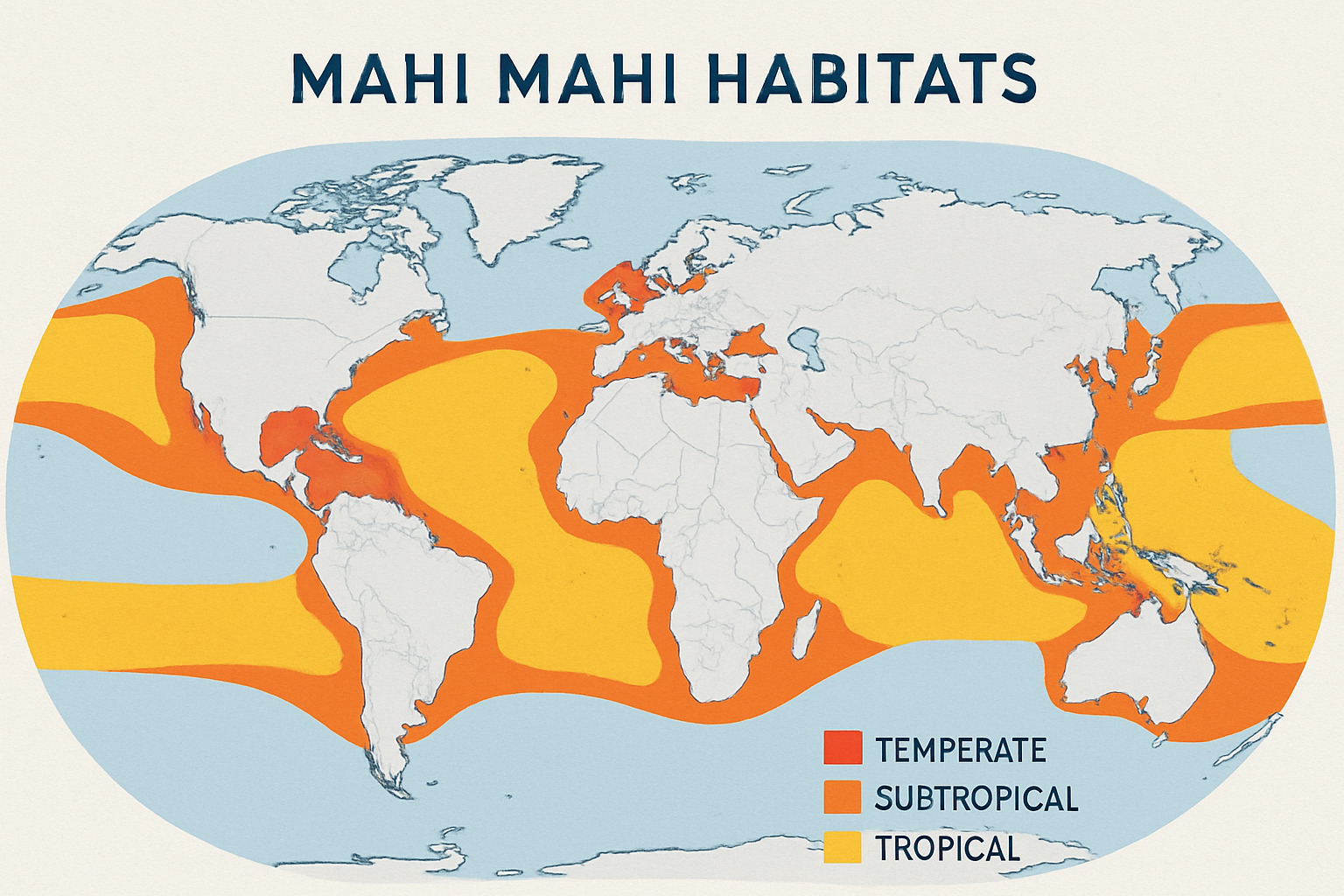
Where Mahi Mahi Thrive
Mahi mahi are true citizens of the world’s warm waters. These fish love temperatures above 68°F and have spread across temperate, tropical, and subtropical waters in the Atlantic, Pacific, and Indian Oceans. From the Gulf of Mexico to the waters off Japan, from the Mediterranean to the coast of Chile, you’ll find these golden beauties making themselves at home.
They’re particularly drawn to areas where different water masses meet, creating convergence zones rich with food. Floating sargassum mats are like underwater restaurants for mahi mahi, providing shelter for the small fish and invertebrates they love to hunt.
The continental shelf edges and underwater seamounts are also prime mahi mahi territory. These areas create upwelling currents that bring nutrients to the surface, supporting the entire food web that keeps these fast-growing fish well-fed.
Biological Superlatives of Mahi Mahi
What makes mahi mahi absolute superstars in the fish world? Their fast growth rate is legendary – they can reach over 4 feet long in their first year of life. That’s like a human baby growing to adult size in 12 months!
Their reproductive abilities are equally impressive. Female mahi mahi demonstrate high fecundity, spawning every 2-3 days once they reach maturity. Each spawning event can release anywhere from 80,000 to 1 million eggs. With numbers like these, it’s no wonder mahi mahi populations can sustain themselves even with regular fishing pressure.
Sport fishermen prize mahi mahi for their incredible game-fish fight. When hooked, these powerful swimmers put on an acrobatic display, leaping and diving with the strength that earned them their Hawaiian name meaning “very strong.” Their combination of speed, strength, and spectacular jumps makes landing a mahi mahi an unforgettable experience for any angler.
Taste, Nutrition & Health Considerations
When you take your first bite of properly cooked mahi mahi, you’ll understand why it’s become such a crowd-pleaser. The flavor is mild and subtly sweet with absolutely no “fishy” taste that might put off seafood newcomers. The texture strikes that perfect balance – firm enough to hold up on the grill, yet flaky and tender when cooked through.
What sets mahi mahi apart from other popular fish is its meaty consistency. It’s denser than halibut but more delicate than swordfish, making it incredibly versatile in the kitchen. Whether you’re grilling, baking, or pan-searing, this fish maintains its structure beautifully.
From a nutritional standpoint, mahi mahi is pretty impressive. You’re getting a lean protein powerhouse – about 20 grams of high-quality protein per 100-gram serving with only 2 grams of total fat. That same serving delivers roughly 0.5 grams of omega-3 fatty acids (the good stuff your heart loves), plus solid amounts of vitamin B12, vitamin D, and selenium.
The mercury question is one many people ask about, and here’s the honest answer: mahi mahi falls into the “moderate mercury” category. The Natural Resources Defense Council suggests limiting yourself to six servings per month. That’s pretty reasonable for most people and makes it a safer choice than larger predatory fish.
| Fish Comparison | Mahi Mahi | Halibut | Swordfish |
|---|---|---|---|
| Flavor | Mild, sweet | Mild, buttery | Meaty, rich |
| Texture | Firm, flaky | Delicate, flaky | Dense, steak-like |
| Mercury Level | Moderate | Low-Moderate | High |
| Protein (per 100g) | 20g | 19g | 20g |
Nutritional Breakdown of Mahi Mahi
Here’s what you’re getting in every 100 grams of cooked mahi mahi: 109 calories packed with 20 grams of protein and just 2 grams of total fat. The omega-3 content hits 0.5 grams, while you’ll also score 23% of your daily vitamin D and nearly half your selenium needs.
The vitamin B12 content is particularly noteworthy – this nutrient is crucial for nerve function and energy metabolism. Plus, you’re getting a good dose of niacin, which supports healthy skin and brain function.
Food Safety Watch-outs
While mahi mahi is generally very safe to eat, there are a couple of things worth knowing about. The mercury consideration we mentioned earlier is the main one – sticking to that six-serving monthly limit keeps you well within safe guidelines.
Ciguatera poisoning is rare but possible with tropical fish like mahi mahi. This happens when fish eat algae containing ciguatoxin, and symptoms can include nausea and neurological effects. Latest research on marine toxins shows that buying from reputable sources dramatically reduces this already-low risk.
There’s also scombroid poisoning to consider, which occurs when fish isn’t properly chilled after being caught. This histamine-related reaction can cause symptoms similar to an allergic reaction within hours of eating. The good news? Rapid chilling after catch prevents this entirely, so buying from quality suppliers is your best protection.
Catch Methods & Sustainability Snapshot
When it comes to responsible seafood choices, mahi mahi truly shines as one of the ocean’s success stories. The way these fish are caught and managed makes them a guilt-free option for environmentally conscious diners.
Most mahi mahi reach your plate through trolling and pole-and-line fishing methods. Picture fishing boats slowly cruising the open ocean, trailing colorful lures behind them. When a mahi mahi strikes, it’s hauled in one fish at a time – no massive nets dragging through the water, no accidental capture of other species.
Unfortunately, not all mahi mahi fishing is created equal. Some operations use longline methods that can accidentally catch sea turtles, sharks, and seabirds as bycatch. That’s why the Monterey Bay Aquarium Seafood Watch specifically recommends US Atlantic mahi mahi as a “Best Choice” while suggesting you avoid imported varieties caught with longlines.
The fish’s biology works in our favor here. Mahi mahi reproduce incredibly quickly – they’re sexually mature at just four months old and can spawn every few days once they’re ready. This rapid reproduction means populations bounce back quickly from fishing pressure, making them naturally sustainable.
More info about Sustainable Food Choices can help you make responsible decisions when shopping for seafood.
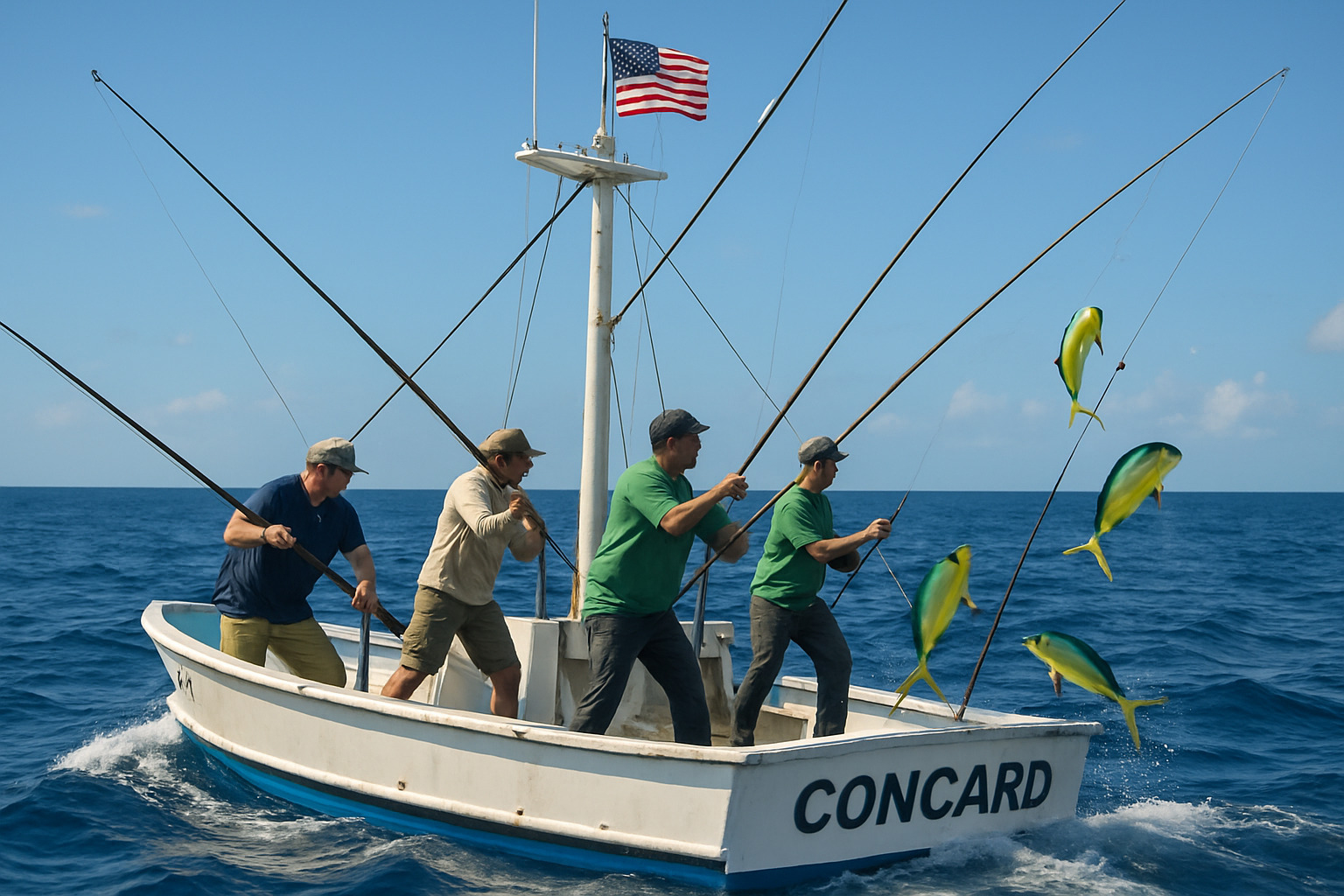
Why Mahi Mahi Rates as a Responsible Choice
The Monterey Bay Aquarium consistently rates properly sourced mahi mahi as their top “Best Choice” recommendation, and it’s easy to see why. These fish grow at lightning speed – gaining up to five pounds per month and reaching full size in just their first year.
NOAA management ensures that US fisheries operate under strict quotas and monitoring programs. Fishing boats must report their catches, and scientists regularly assess population health to ensure sustainable harvest levels.
Since mahi mahi live near the ocean’s surface, the fishing gear used to catch them rarely touches sensitive bottom habitats like coral reefs or seafloor communities. This means minimal habitat impact compared to bottom-trawling operations that can damage marine ecosystems.
The numbers tell the sustainability story clearly: female mahi mahi can release up to one million eggs per spawning event, and they spawn multiple times throughout the year. This incredible reproductive capacity means populations can withstand reasonable fishing pressure without declining.
Traditional & Recreational Fishing Highlights
Mahi mahi fishing traditions span cultures and continents, each adding their own flair to pursuing these spectacular fish.
In French Polynesia, fishermen practice poti marara harpooning – a thrilling method where specialized high-speed boats with distinctive V-shaped hulls chase down mahi mahi in open water. The skill required to harpoon a fish swimming at 50 knots is truly impressive.
The Philippines’ remote Batanes province has its own tradition called pagmamamataw – another harpooning technique that targets mahi mahi and other fast-swimming pelagic species.
For sport trolling enthusiasts, mahi mahi represent the perfect game fish. They put up spectacular fights, leaping clear out of the water multiple times when hooked. Experienced anglers know to look for floating debris, circling frigatebirds, or lines of sargassum seaweed – these are the places where mahi mahi like to hunt and congregate.
Selecting, Storing & Preparing Mahi Mahi Fillets
Proper selection and handling are crucial for getting the best from your mahi mahi. When buying whole fish, look for clear, bright eyes, vibrant skin coloration, and firm flesh that springs back when pressed. The gills should be bright red, and there should be no strong fishy odor.
For fillets, choose pieces with translucent, pinkish flesh and avoid any that look grey, brown, or have gaps in the muscle structure. Store mahi mahi at 32°F on ice and plan to cook within 1-2 days of purchase. For longer storage, wrap tightly and freeze for up to 4 months.
Before cooking, you’ll need to remove the skin (if present) and trim away the dark red bloodline that runs through the center of the fillet. While the bloodline is safe to eat, it has a stronger, more “fishy” flavor that many people prefer to remove.
Step-By-Step Prep for Mahi Mahi
- Pat dry: Use paper towels to remove excess moisture
- Remove skin: Use a sharp, thin knife to separate skin from flesh
- Trim bloodline: Cut out the dark red muscle running through the center
- Check for bones: Run your fingers along the fillet and remove any pin bones with tweezers
- Portion: Cut into 6-ounce serving sizes for even cooking
- Season last: Add salt and seasonings just before cooking to prevent drawing out moisture
For sashimi-grade mahi mahi, ensure it’s been properly frozen to eliminate parasites. More info about Sashimi covers the specific requirements for raw fish preparation.
Smart Buying Tips
- Look for MSC (Marine Stewardship Council) certification labels
- Ask your fishmonger about the catch method – prefer troll or pole-and-line caught
- Choose vacuum-packed frozen fillets if fresh isn’t available
- Buy from reputable suppliers who can trace their fish back to the source
- Consider locally caught mahi mahi during peak seasons (March-May and September-November in many regions)
Cooking Techniques & Crowd-Pleaser Recipes
The beauty of mahi mahi lies in its incredible versatility – this fish practically begs to be experimented with in the kitchen. Its firm, meaty texture holds up beautifully to high-heat cooking methods, while its mild flavor acts like a culinary canvas, ready to absorb whatever flavors you throw at it.
The golden rule with mahi mahi is simple: don’t overthink it, and definitely don’t overcook it. This lean fish can go from perfectly flaky to disappointingly dry in a matter of minutes. Your target is an internal temperature of 135-140°F – at this point, the flesh will flake easily with a fork but still retain its moisture and delicate texture.
Whether you’re grilling for that perfect char, baking for hands-off simplicity, pan-searing for a restaurant-quality crust, or even steaming for the most delicate preparation, mahi mahi delivers every time. It’s equally at home in a ceviche where the citrus “cooks” the fish, or in hearty fish tacos that’ll have your family asking for seconds.
The flavor pairings are where things get really exciting. Mahi mahi has this amazing ability to transport you to tropical destinations – it practically sings when paired with citrus, mango, pineapple, and coconut. But don’t box yourself in – Mediterranean herbs, Asian-inspired glazes, and classic American preparations all work beautifully.
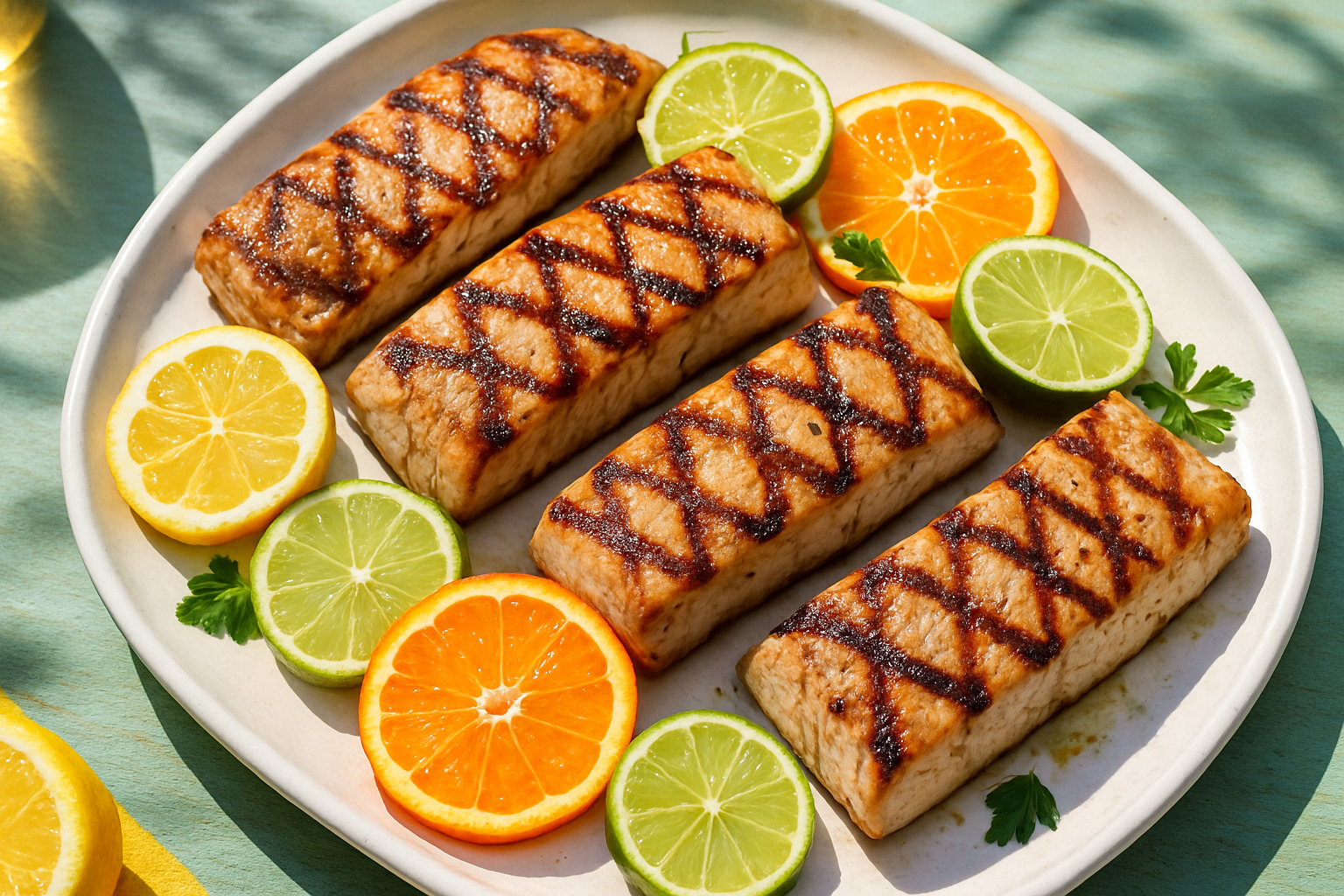
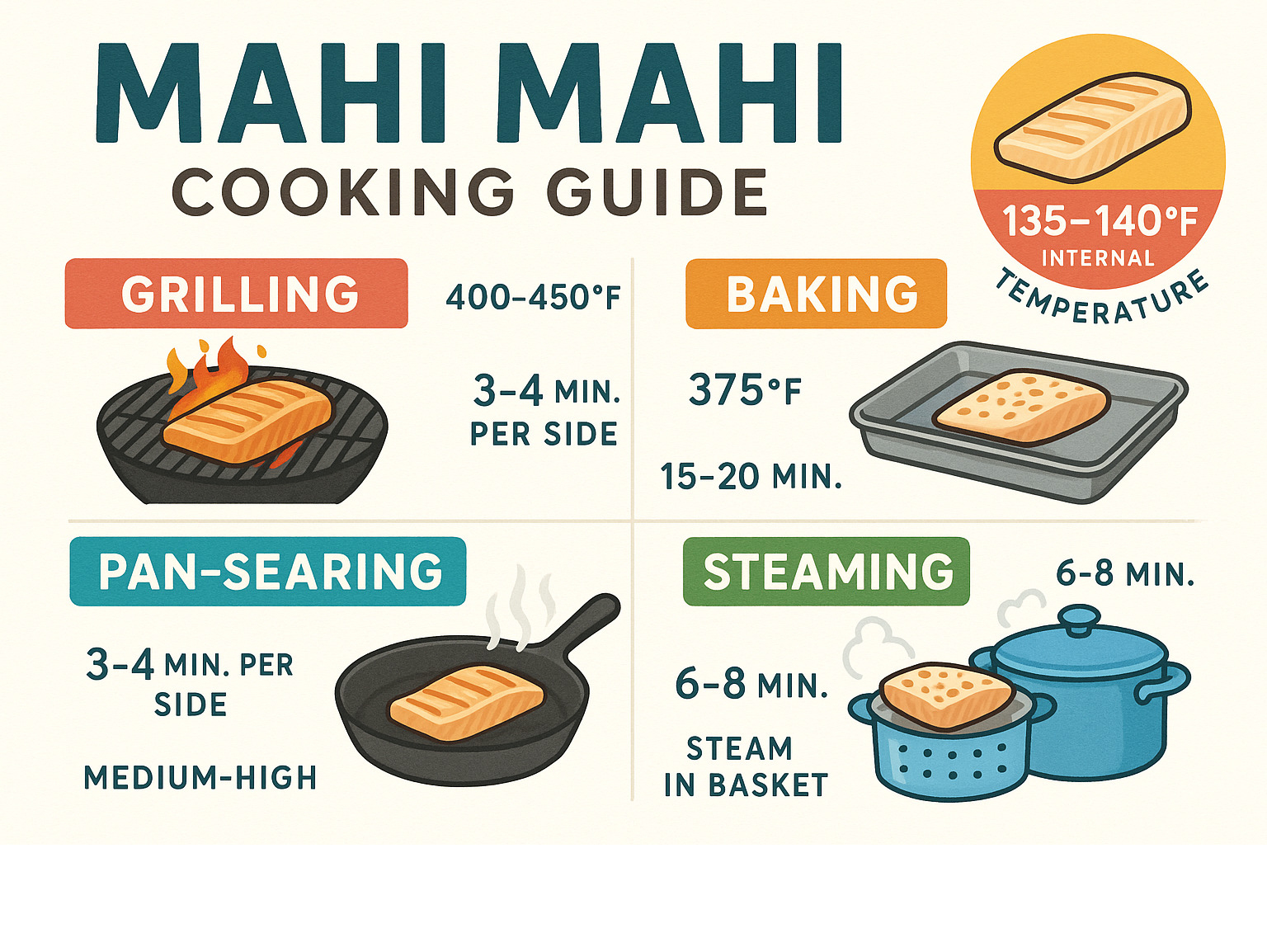
Grilling Mahi Mahi to Perfection
There’s something magical about mahi mahi kissed by flames – the high heat creates this gorgeous caramelized crust while keeping the inside incredibly moist and flaky. It’s honestly one of our favorite ways to prepare this fish, especially during those warm summer evenings when you want something light but satisfying.
Start by getting your grill nice and hot – we’re talking medium-high heat around 400-450°F. The biggest mistake people make is not properly oiling the grates. Trust us on this one – a well-oiled grill is the difference between beautifully intact fillets and a frustrating mess of fish stuck to your grates.
Pat those fillets completely dry before they hit the grill. Any excess moisture will create steam and prevent that beautiful sear we’re after. A simple seasoning of salt and pepper is often all you need, though a light brush of olive oil helps prevent sticking and adds flavor.
The timing is crucial: 2-4 minutes per side depending on the thickness of your fillets. Resist the urge to move or flip the fish multiple times – flip only once to keep everything intact. You’ll know it’s ready when the flesh easily releases from the grates and your thermometer reads 135-140°F internal temperature.
Here’s a pro tip that’ll change your grilling game: brush your mahi mahi with a light glaze or marinade before grilling. Not only does this add incredible flavor, but it also creates a protective barrier that helps prevent sticking and keeps the fish moist.
Versatile Recipe Ideas Featuring Mahi Mahi
Fish tacos might just be the perfect vehicle for mahi mahi. Grill or pan-sear your fillets, flake them into bite-sized pieces, and nestle them into warm tortillas with fresh mango salsa, creamy avocado, and a drizzle of lime crema. It’s like a vacation in every bite.
For something more neat, try the classic lemon garlic butter preparation. Pan-sear your mahi mahi until golden, then finish with a simple sauce of melted butter, minced garlic, fresh lemon juice, and whatever herbs you have on hand. It’s restaurant-quality dining in your own kitchen.
If you’re feeling adventurous, coconut curry transforms mahi mahi into something completely different. Simmer the fish gently in rich coconut milk with Thai curry paste, your favorite vegetables, and serve over jasmine rice. The mild fish absorbs all those complex flavors beautifully.
A citrus glaze made from orange juice, honey, soy sauce, and fresh ginger creates this amazing sweet-savory coating that caramelizes beautifully whether you’re baking or grilling. And don’t sleep on pineapple salsa – the combination of sweet pineapple, sharp red onion, spicy jalapeño, fresh cilantro, and bright lime juice is absolutely perfect with the mild fish.
For those interested in exploring other fish preparations, our Salmon Recipe guide offers some great comparison techniques that work beautifully with mahi mahi too.
Frequently Asked Questions about Mahi Mahi
If you’re curious about mahi mahi, you’re not alone! This popular fish raises some common questions, especially for first-time buyers. Let’s clear up the most frequent mysteries surrounding this delicious catch.
What does mahi mahi taste like?
Mahi mahi is the perfect fish for people who think they don’t like fish. It has a mild, slightly sweet flavor with absolutely no “fishy” aftertaste that turns many people off from seafood. The texture is what really sets it apart – it’s firm and meaty, denser than something like cod but not as heavy as tuna.
When cooked properly, mahi mahi flakes beautifully into thick, satisfying pieces. Think of it as the chicken breast of the seafood world – neutral enough to take on whatever flavors you pair with it, but delicious enough to stand on its own with just a squeeze of lemon.
This adaptable flavor profile makes mahi mahi incredibly versatile in the kitchen. Whether you’re grilling it with Caribbean spices, pan-searing with garlic and herbs, or using it in fish tacos, it absorbs seasonings beautifully while maintaining its own subtle sweetness.
Is mahi mahi the same as dolphin?
This is probably the most common source of confusion about mahi mahi! Despite being called “dolphinfish,” mahi mahi is absolutely not related to dolphins in any way. It’s a classic case of unfortunate naming that has confused diners for decades.
Dolphins are marine mammals – they’re warm-blooded, breathe air through lungs, give birth to live babies, and nurse them with milk. Mahi mahi are fish – they’re cold-blooded, breathe through gills, and lay eggs. The only thing they share is living in the ocean!
The name “dolphinfish” likely comes from the fish’s playful jumping behavior when hooked, which reminded early fishermen of dolphins leaping. Many restaurants and markets now prefer using the Hawaiian name “mahi mahi” specifically to avoid this confusion and make diners more comfortable ordering it.
How often is it safe to eat mahi mahi?
Mahi mahi falls into the “moderate mercury” category, which means you can enjoy it regularly but with some awareness. The Natural Resources Defense Council recommends limiting consumption to six servings or fewer per month for most adults.
This makes mahi mahi a much safer choice than high-mercury fish like shark, king mackerel, or large tuna. It’s also safer than swordfish, which is in the same moderate category but tends to have slightly higher mercury levels.
Pregnant women and young children should be more cautious with moderate-mercury fish, potentially limiting servings to 2-3 per month and consulting with their healthcare provider. For most healthy adults, though, enjoying mahi mahi once or twice a week is perfectly fine and gives you all those wonderful omega-3 benefits without overdoing the mercury exposure.
Conclusion
Mahi mahi truly is the ocean’s gift to seafood lovers everywhere. This remarkable fish combines everything we could ask for – incredible flavor, impressive nutrition, responsible harvesting, and endless culinary possibilities. From the moment you see its brilliant colors flash beneath the waves to the last bite of perfectly grilled fillet, mahi mahi delivers an experience that’s hard to forget.
What makes this fish so special isn’t just its mild, sweet taste or firm texture that works beautifully in everything from casual fish tacos to neat restaurant presentations. It’s the peace of mind that comes with knowing your dinner choice supports healthy ocean ecosystems through sustainable fishing practices.
The rapid growth and prolific reproduction of mahi mahi means we can enjoy this delicious fish without worrying about overfishing. When you choose hook-and-line caught mahi mahi, especially from US Atlantic waters, you’re supporting fishing methods that protect marine habitats and minimize bycatch.
Whether you’re a seasoned cook looking to expand your seafood repertoire or someone just beginning to explore fish beyond the usual suspects, mahi mahi offers the perfect starting point. Its forgiving nature means it’s hard to mess up, while its versatility means you’ll never run out of new ways to prepare it.
The next time you’re at the market or scanning a restaurant menu, remember what makes mahi mahi such a standout choice. You’re not just selecting dinner – you’re choosing a fish that represents the future of responsible seafood consumption. For more guidance on making thoughtful dining decisions, explore our sustainable dining practices resources.
Here at The Dining Destination in New York City, we believe that great food should never come at the expense of our oceans. Mahi mahi proves that we can have both exceptional taste and environmental responsibility on the same plate – and that’s something worth celebrating.

